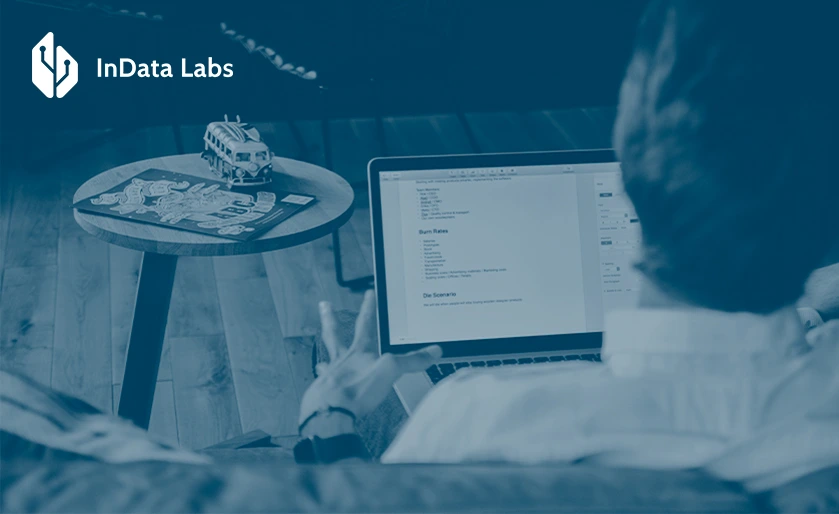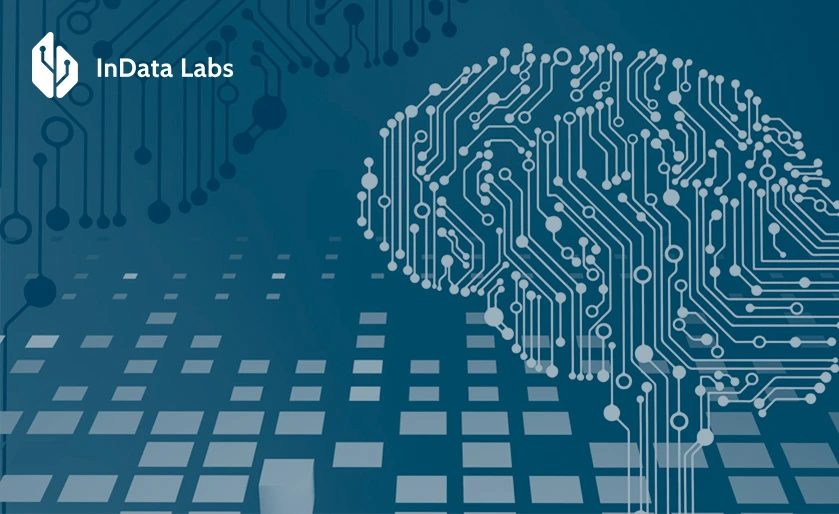In an era where data fuels decision-making, the real magic lies in how you decipher it. Lately, AI business solutions have emerged as a practical and transformative toolkit for businesses.
Businesses are increasingly leveraging machine learning algorithms to predict market fluctuations, utilize neural networks to enhance customer experience, and employ natural language processing to automate and innovate customer service.
In this article, we won’t just scratch the surface but explore the top 11 AI business solutions that AI enables. These technologies are powered by AI to drive tangible results and set new benchmarks in their respective domains.
Let’s move beyond the jargon and see AI in action.
NLP and GenAI for customer services
Businesses leveraging customer service to enhance overall brand image can benefit from adopting natural language processing (NLP) technology. This is one of the key AI solutions for the business that transforms customer service with its AI-powered core, enabling systems to understand, interpret, and respond to human language meaningfully and contextually.
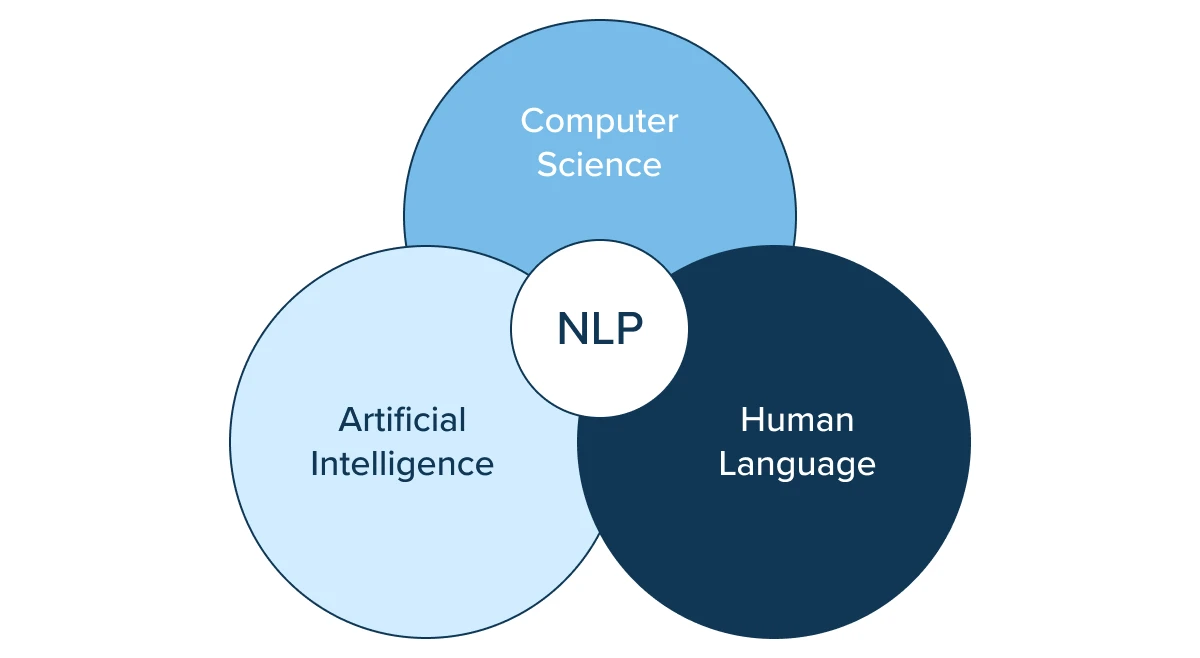
This AI solution is aimed at facilitating seamless customer interaction and automated service systems mimicking human conversation.
Advantages
Enhanced customer experience: NLP systems provide immediate responses to customer queries by eliminating wait times associated with human operators. Such 24/7 availability ensures customers receive support whenever needed, significantly enhancing the overall customer experience.
Efficiency and cost-effectiveness: Automated customer service through NLP reduces the need for large customer service teams, contributing to cost savings. It also allows human customer service representatives to focus on more complex queries, improving overall efficiency.
Scalability: NLP systems can handle a large volume of queries simultaneously, something that would require substantial human resources to match. This scalability is crucial for handling peak times or sudden increases in customer inquiries.
Examples
- InData Labs AI virtual assistant Aurora Borea: The chatbot handles queries about the company’s services and products tailored to the specific client’s request.
- IBM Watson Assistant: IBM’s Watson Assistant uses advanced NLP to understand customer queries and context.
- Google Dialogflow: Dialogflow enables developers to build natural and rich conversational experiences over chatbots and voice apps for customer service.
Dynamic pricing and AI technology
Dynamic pricing is a strategy AI-powered technology that brings a significant shift in how businesses approach pricing. This AI-backed technology enables real-time pricing adjustments based on market demand, competitor pricing, and other relevant data points.
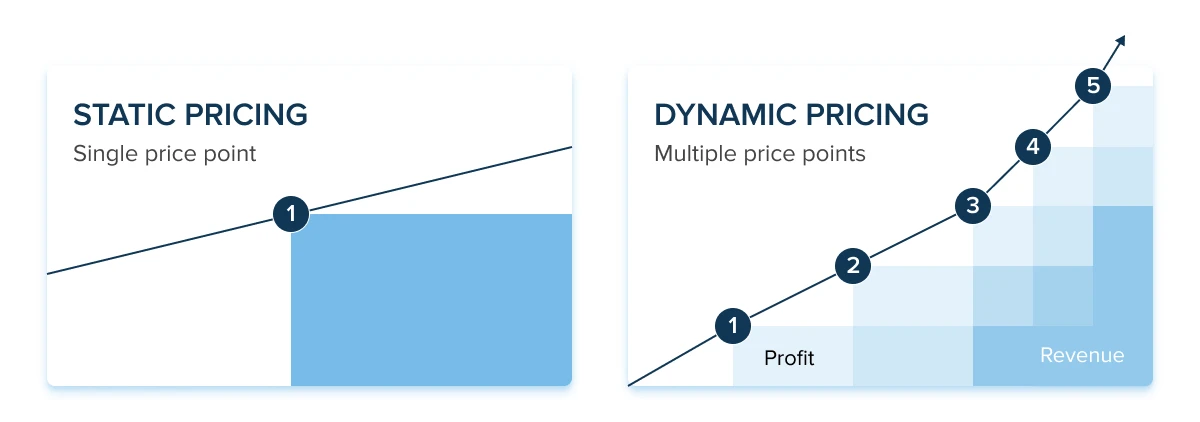
In SaaS, for instance, metrics such as customer lifetime value (CLV), churn rate, and monthly recurring revenue (MRR) are pivotal. Dynamic pricing directly impacts such SaaS metrics and brings out real insights. Marketers can then use these insights to strategically adjust prices to optimize customer retention and revenue.
For instance, during periods of high demand or when user engagement is robust, prices can be calibrated higher, contributing to an increased MRR. Similarly, lower demand or higher churn risk situations require taking prices downward to retain customers to positively impact the churn rate.
Advantages
Quick market response: It allows businesses to respond quickly to market changes, ensuring prices remain competitive and attractive to customers. The profit maximizes since it can intelligently adjust prices based on demand in a way where prices shoot up during high demand. Conversely, prices can be lowered in slower periods to attract more customers. Something that we all are familiar with when it comes to checking hotel and flight prices.
Pricing efficiency: AI eliminates the guesswork of manually analyzing demands and making pricing decisions, saving time and resources. This efficiency also extends to improved customer satisfaction since it offers competitive prices to attract and retain them.
Examples
- Omnia Dynamic Pricing: Omnia’s tool leverages AI to adjust prices automatically based on internal data and external market conditions, helping retailers stay competitive and profitable.
- Pricewell: Pricewell uses AI to help subscription-based services dynamically adjust their pricing, taking into account customer behavior and willingness to pay, maximizing revenue and customer lifetime value.
Automated CRM and AI
AI powers Automated Customer Relationship Management (CRM) systems to revolutionize how businesses interact with customers. Such CRM tools are adept at automating routine tasks like updating records, scheduling appointments, and prioritizing potential leads. Implementing AI in CRM systems brings about the automation of mundane tasks. This saves time and reduces chances of human error, leading to accurate and up-to-date customer records.
Advantages
Customer data analysis: Automated CRM has AI algorithms that analyze customer data to identify patterns and insights in customer behavior. Such data analytical solutions help businesses tailor their approach and personalize customer interactions resulting in higher customer satisfaction and loyalty with the data analytical solutions.
Lead prioritization: AI-driven CRM tools also excel in lead prioritization by analyzing past interactions and customer data. It can identify the likelier leads to convert, allowing sales teams to focus their efforts where they are most likely to yield results.
Examples
- Zoho CRM: Zoho adopts AI to provide sales trend analytics, lead scoring, and even sentiment analysis to understand customers better.
- Microsoft Dynamics 365 AI: It offers a blend of CRM and ERP capabilities with AI to offer insights, automate processes, and personalize customer experiences.
- HubSpot CRM: HubSpot integrates AI into its CRM for functionalities like predictive lead scoring and detailed customer insights. This helps manage sales strategies for better customer engagement.
AI-enhanced fraud detection
This AI-based solution helps identify and prevent fraudulent activities in business transactions. This technology learns from historical data and continuously adapts to recognize complex patterns and anomalies indicative of fraud.
Its rapid, accurate detection and the ability to adapt to new fraudulent techniques provide a robust shield against rampant online fraud. Leveraging this solution secures businesses financially and bolsters customer trust and reliability in the digital transaction ecosystem.
Advantages
High accuracy: Learning from historical data can help AI systems accurately identify fraudulent activities, reducing false positives and negatives.
Adaptability: AI models continuously learn and adapt to new fraudulent techniques, ensuring businesses stay ahead of evolving threats.
Cost-effective: Automating fraud detection helps businesses save on labor costs and reduce losses due to fraud.
Examples
- IBM Trusteer: This tool helps organizations detect fraud, authenticate users, and establish identity trust across the omnichannel customer journey.
- Kount: An AI-driven fraud prevention solution, Kount provides real-time fraud detection and prevention for online businesses and payment platforms.
Machine learning for personalized recommendations
Machine Learning (ML) for personalized recommendations adopts sophisticated AI to tailor product or service suggestions for individual customer preferences and behaviors.
This technology adopts algorithms that analyze vast amounts of data about a customer’s past interactions, purchase history, browsing patterns, and social media activity. Ultimately, businesses will have a lowdown on customer’s preferences and predict what they might want or need next.
Advantages
Enhanced customer experience: ML-driven recommendations provide a personalized shopping experience by showing them the products or services that align closely with their interests and needs. This makes their interaction with the brand more relevant and engaging.
Increased customer loyalty and retention: Consistently providing relevant suggestions enables businesses to foster understanding and connection with their customers. In turn, this helps drive customer loyalty and retention.
Efficient discovery of new products: ML algorithms can introduce customers to products or services they might not have discovered otherwise. This business AI solution can thus expand the purchasing horizon and drive diverse product exposure to boost reach.
Examples
- InData Labs’ AI recommendations engine: A custom-built recommendation engine analyzes the company’s data and provides tailored recommendations. It helps the company to provide more personalized experiences and improve customer loyalty.
- Amazon’s recommendation engine: Amazon uses ML to recommend products based on previous purchases, search history, and items in the shopping cart. Such personalization enhances the shopping experience and significantly drives Amazon’s sales.
- Netflix’s content suggestions: Netflix employs ML algorithms to suggest movies and TV shows based on a user’s viewing history and ratings. This keeps users engaged and reduces the time spent searching for content.
- Spotify’s music discovery: Spotify uses ML to create personalized playlists like Discover Weekly that introduce users to new music tailored to their listening habits.
Customer sentiment analysis
Customer sentiment analysis delves into understanding customer opinions and feedback from various digital platforms, such as social media and review sites.

At its core, AI uses advanced algorithms to analyze text for emotional tone and sentiment. It gives businesses critical insights into how customers perceive their brand, products, or services.
Advantages
Proactive reputation management: Businesses quickly unlock real-time feedback to address negative sentiments, enabling them to protect and enhance their brand reputation.
Competitive analysis: With such analysis, businesses can monitor competitors’ customer sentiment to gain a strategic advantage in understanding their market position and gauge customer loyalty.
Improved product and service development: Insights from sentiment analysis can guide product development and service improvements, enabling businesses to align their offerings more closely with customer expectations and demands.
Examples
- InData Labs’ custom sentiment analysis solutions: Real-time sentiment analysis allows for an end-to-end view of your consumer preferences and emotional coloring analysis. Using sentiment analysis you can track and classify queries, comments, emails, and other data to reduce the time and costs of customer service.
- Brandwatch: It analyzes online conversations and provides insights into sentiment trends, helping businesses understand how users perceive their brand in a digital sphere.
- NetBase Quid: NetBase Quid provides a platform for real-time sentiment analysis, helping brands understand customer emotions and opinions and adjust their strategies accordingly.
RPA for workflow optimization
RPA is an AI technology that automates routine processes traditionally performed by human employees. This technology utilizes software robots or bots to perform tasks such as data entry, processing transactions, or managing emails.
In its workings, this one begins with observing how users perform a particular task in the application’s graphical user interface (GUI). And then, it performs the automation by repeating those tasks directly in the GUI.
Advantages
Automating routine tasks minimizes the need for manual labor, resulting in significant cost savings for businesses.
Better accuracy: RPA reduces the risk of human error in repetitive tasks to offer high accuracy in data processing and other routine tasks.
Increased efficiency and productivity: RPA bots work tirelessly and quickly to complete tasks faster and more accurately than humans, resulting in increased operational efficiency.
Scalability and flexibility: It is easy to scale up or down the RPA systems, allowing businesses to adjust their automation processes in response to changing needs and workload demands.
Examples
- UiPath: This recognized RPA tool can automate various business processes to enhance productivity and efficiency across numerous operations.
- Blue Prism: This software offers a digital workforce that helps businesses automate complex, end-to-end operational activities to better their agility and performance.
AI-assisted design and development
AI-assisted design and development is changing how we approach creating and refining products and systems. This AI integration quickly analyzes large data sets and identifies trends and patterns that inform the design process. This capability is particularly useful in tailoring products to specific market segments or user preferences.
Moreover, it also suggests improvements and offers optimization options by simulating various design scenarios. This way, it predicts potential issues and suggests alterations, often identifying solutions that may not be immediately apparent to human designers.
Advantages
Enhanced creativity and innovation: AI provides designers with new perspectives and solutions, fostering greater creativity and innovation in design projects.
Predictive problem-solving: AI-assisted design tools can foresee potential design flaws or inefficiencies by analyzing similar past projects and current design parameters. This predictive capability helps preemptively address issues, reducing the need for time-consuming revisions later.
Integrating with complex data sets: Leveraging AI-driven design and development tools helps manage and integrate complex (and diverse) data sets into the design process. Such integration allows for more informed, data-driven design decisions, especially in complex urban planning or aerospace fields.
Examples
- Adobe Sensei: Adobe’s AI and machine learning technology, Sensei, is integrated into its creative cloud suite. It is designed to assist businesses in tasks like image editing, pattern recognition, and suggesting design elements.
- Autodesk’s Generative Design: This tool uses AI to explore a solution’s possible permutations, generate design alternatives, and learn from each iteration. For more, check out how generative AI progresses to create an output that resonates with your brief.
Sales forecasting with AI
Using AI for sales forecasting is a game-changer. It takes a deep look at your historical sales data, then layers in external factors like market trends, economic conditions, and consumer behaviors. It goes beyond number crunching by bringing in smart analysis to analyze complex data and offer predictions about future sales with impressive accuracy.
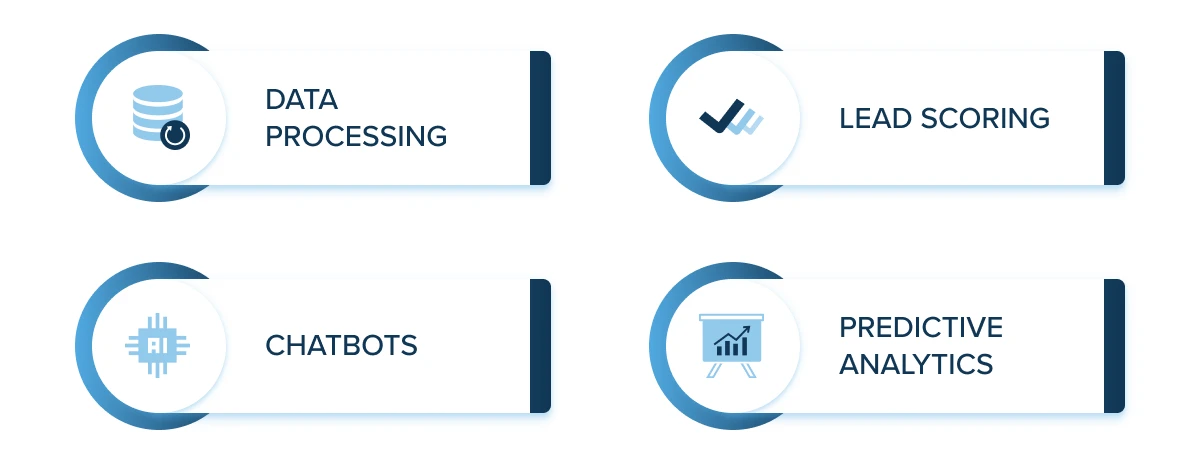
This AI-backed tech is aimed at informed decision-making that helps key personnel confidently plan and minimize uncertainties.
Advantages of AI in sales forecasting
Time efficiency: AI automates the time-consuming data analysis task to free up time for key decision-makers to focus on strategizing business activities.
Resource optimization: By predicting future sales, businesses can better manage inventory levels, reducing overstock and stockouts, thus optimizing resource usage.
Adaptability: AI systems can quickly adjust forecasts based on real-time data that ensure businesses stay aligned with current market dynamics.
Examples
- Salesforce Einstein: This is a Salesforce AI platform that offers sales forecasting by analyzing CRM data. It provides sales teams with predictions and insights to guide their efforts.
- SAP Integrated Business Planning: This tool uses AI to forecast sales, integrating data from various sources to comprehensively view potential sales outcomes.
Business Intelligence and AI-driven data analysis
Business Intelligence (BI) is revolutionizing how companies make decisions. Integrating AI BI tools can transform vast amounts of raw data into actionable insights. This isn’t just about sorting through numbers; it’s about uncovering hidden trends, patterns, and correlations that could go unnoticed.
Business analytics and AI blends can efficiently process large datasets to provide businesses with a comprehensive view of their operations, highlighting key areas for strategic decision-making. It’s all about making data more accessible and understandable, enabling businesses to swiftly make smarter, data-driven decisions.
Advantages of BI and AI-driven data analysis
Customized reporting: The artificial intelligence business solutions AI can generate tailored reports focusing on specific areas of interest, providing relevant information for different departments.
Complex pattern recognition: BI tools have AI algorithms in the backend to identify complex patterns and anomalies in large datasets.
NLP for data queries: AI-driven BI tools often include NLP capabilities that enable users to query data in natural language. This makes data analytics accessible to non-technical users to foster a data-driven culture across various departments.
Examples
- Microsoft Power BI: Integrates AI to provide rich data analytics and visualization tools, helping businesses to analyze data from various sources and gain comprehensive insights.
- Qlik: This tool features AI and cognitive functions that enhance data analysis to help businesses explore their data intuitively and make data-driven decisions.
Content creation
Have you noticed how AI is shaking things up in content creation? It’s like having a supercharged assistant for writing, graphic design, and video production. But here’s the thing – it’s not just about speeding things up. AI is bringing a new level of creativity and efficiency to content marketing.
Consider AI in content creation as a savvy analyst and a creative whiz rolled into one that dives into oceans of data, sifting through complex algorithms. Ultimately, it understands and learns from what’s already out there.
When it comes to writing, for example, it’s not just spitting out words but crafting stories that make sense, resonate with the audience, and fit perfectly within the language’s structure. Moreover, with GPT integration in place, you can perform a variety of tasks based on natural language processing to get the desired output.
Advantages of AI in creating content
Consistency and quality control: AI tools maintain a consistent style and tone across all content, ensuring a uniform brand voice, and they can also help maintain high-quality standards.
Time efficiency: This AI business solution can significantly speed up the content creation process. What used to take hours or days can now be done in minutes, freeing creators to focus on more strategic tasks.
Multilingual content: Efficiently create content in multiple languages. This makes it easier for businesses to reach a global audience without extensive translation services.
Examples
- ChatGPT by OpenAI: This advanced language model can generate human-like text, making it useful for creating articles, stories, and poetry.
- Lumen5: This video creation platform uses AI to transform text content into engaging video stories, ideal for social media marketing.
- Adobe Photoshop’s AI features: Adobe has integrated AI for various tasks like photo editing and graphic creation to make complex edits simpler and more intuitive.
Over to you
Preparing yourself to enter the world of AI business solutions feels like unlocking a treasure chest for businesses. But it’s more than just fancy tech since all these AI solutions in business can make jobs easier, help understand customers better, and provide that extra nudge toward success.
Therefore, integrating such solutions across different business processes helps prepare for current challenges and future-proof businesses for evolving landscapes.
So far, we have looked at eleven AI solutions in business here, but it is not about having the fanciest AI tools but how you use them (depending on your business needs). So, dive in, get hands-on, and see where these innovations can take your business.
Author bio
Carl Torrence is a Content Marketer. His core expertise lies in developing data-driven content for brands, SaaS businesses, and agencies. In his free time, he enjoys binge-watching time-travel movies and listening to Linkin Park and Coldplay albums.


